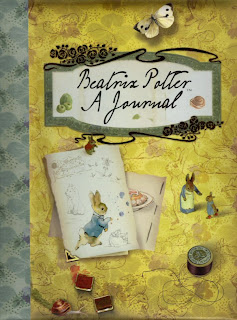Tuesday, December 22, 2009
Beatrix Potter - a Journal
On the end page of the front cover is a letter dated December 10th, 1925, written to an American woman who had asked her for details about how she came to write "The Tale of Peter Rabbit."
The journal begins with an entry dated 1882 "I was sixteen when I decided to start this dairy. I was beginning to feel the peaceful time of childhood was ending and I foresaw changes in my life." There is a family tree with photos of each member as well as photos of her London home and their holiday home in Scotland.
Photos and sketches and paintings and handwritten diary entries fill the pages. Bits and pieces open up to show something new. An envelope contains a two-page letter.
She was married to William Heelis in 1913, and led a "busy, contented life managing my own land (Hill Top Farm) among the mountains and lakes that I have drawn in my books."
An extra surprise is hidden in the endpage of the back cover - a privately printed edition of "The Tale of Peter Rabbit". A small hard cover book about 4" x 5" lifts right out, and there are Flopsy, Mopsy, Cotton-tail and Peter just as we have always loved them.
Wednesday, November 25, 2009
My Secret War Diary
1939-1945
by Marcia Williams
Candlewick Press

This is a charming childrens' book, and I enjoyed every single page. From the magnificent marbled endpapers in the front to the glossary page at the back. The glossary explained many terms that were previously unknown to me ... like Anderson shelter (an outdoor air-raid shelter) and Morrison shelter (an indoor air-raid shelter).
The scrapbook format and fold-out letters break up the crowded pages with lots of text and drawings.
Saturday, November 7, 2009
Letters from Hawaii

Audio Book 2004
read by McAvoy Layne
McAvoy Layne is a Mark Twain scholar, renowned for his Twain impressions performed throughout the world
This is a collection of letters written by Mark Twain in 1866 when he was sent by the Sacramento Union to the Sandwich Islands (now known as Hawaii). He says "this is the loveliest fleet of islands that lie anchored in any ocean".
He describes his journey out, his impressions of Honolulu and Oahu, the local government (still a monarchy at this time), the economy (particularly whaling and sugar cultivation), the role of the Americans and the British in Hawaii, and the role of the missionaries.
His account of the sailors who survived over 40 days at sea in lifeboats and landed on one of the Hawaiian islands is a highlight. Twain's irreverence for all religious beliefs is in good showing as well
His description of horseback riding in the mountains had me laughing out loud
I’m particularly enjoying listening to these letters on a cold and rainy day in the Pacific Northwest … remembering the three years I lived in Hawaii.
Friday, November 6, 2009
Reading Places
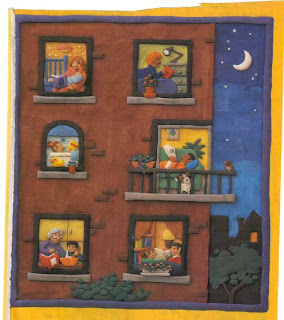
Do you have a favorite place for reading? a favorite room? a favorite time or position?
I wish I had a big comfy chair and a fireplace and a cat. But I don't. So then, my favorite place is in bed, especially on a cold rainy night ... with lots of pillows and quilts and maybe a cup of tea.
How about a companion? Do you like to read with some one else? a friend? a family member? Sometimes I like to read in the library with lots of other people.
Tuesday, November 3, 2009
Teaser Tuesdays/The Umbrella Man
 Teaser Tuesdays is a weekly bookish meme, hosted by MizB. Anyone can play along! Just do the following:
Teaser Tuesdays is a weekly bookish meme, hosted by MizB. Anyone can play along! Just do the following:Grab your current read. Open to a random page. Share two (2) “teaser” sentences from somewhere on that page. BE CAREFUL NOT TO INCLUDE SPOILERS! (make sure that what you share doesn’t give too much away! You don’t want to ruin the book for others!).
Share the title & author, too, so that other TT participants can add the book to their TBR Lists if they like your teasers!
The little man carefully removed the red band from his still unlighted cigar. "I never ask you my friend, to bet something you cannot afford. You understand?"
"Then what do I bet?"
"Some small ting you can afford to give away, and if you happen to lose it you would not feel too bad. Right?"
"Such as what?"
"Such as, perhaps, the little finger on your left hand."
pg.59 The Umbrella Man
and Other Stories
by Roald Dahl 1996
Tuesday, October 27, 2009
Winter Dreams
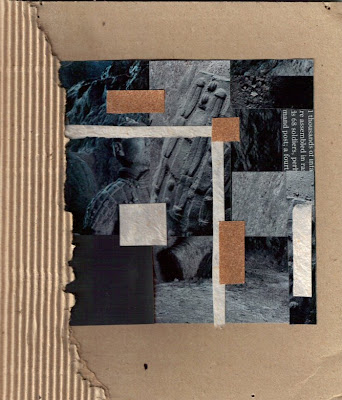
Since reading Anne Michaels' Winter Vault, my dreams have been filled with images from those stories of destruction - sand and rocks from Egypt, snow and rocks from Warsaw, and earth and rocks from the Saint Lawrence Seaway. This novel has touched me deeply and will stay with me for a long, long time.
This morning I made a collage of bits and pieces - clips from magazines, corrugated paper, sand paper, black construction paper and white handmade paper.
Monday, October 19, 2009
The Winter Vault
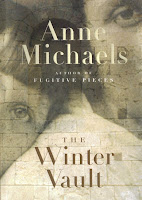
by Anne Michaels
McClelland & Stewart
2009
This book came to me six months ago in a large box with others I'd ordered. I'd read her first novel Fugitive Pieces several years ago and was very moved by it. And it was adapted into an acclaimed major feature film a few years later.
The books went onto the shelf marked TBR, and I forgot about it until last week when I learned it had been nominated for the Giller Prize. I picked it up a few nights ago and haven't been able to put it down since.
This is a story of love and loss, personal loss and collective loss on a scale that is difficult to imagine. With a poet's intense imagery, Anne Michaels takes us with Jean Shaw and her engineer husband to Nubia as it is about to be inundated by the newly formed Lake Nasser. This experience reminds Jean of the villages that were likewise flooded by the construction of the St. Lawrence Seaway, several years before. What happens when villages like these, and cities (like Warsaw in WWII) are destroyed? How do people find ways to live and love after such events?
Fascinating and horrifying are the interwoven stories of displacement (whole towns that were displaced when the St. Lawrence Seaway was built in Canada, thousands of Nubian villagers lost their homes and civilization when the Aswan Dam flooded the Nile to form Lake Nassar, people who fled their homes to escape the Nazis.
Avery Escher is an engineer and Jean Shaw a student botanist. They meet in a dry river bed on the banks of the St. Lawrence River in Canada, witnessing the construction of the Seaway as it swallowed towns, homes, and lives. Now, at the edge of another world about to be inundated in the name of progress, much of what they most believe in is tested. Avery looking out upon a space his father, also an engineer, created (or destroyed) by diverting a river; Jean, collecting native plant species along the banks in order to save them – and the memory of her mother’s garden.
In 1964, they settle into a houseboat on the Nile just below Abu Simbel. At the time of the building of the Aswam dam, Avery is one of the engineers responsible for the dismantling and reconstruction of a sacred temple, a “machine-worshipper” who is nonetheless sensitive to their destructive power. Jean is passionately interested in everything that grows.
I've wept on many pages describing the displacement of thousands, their homes and their culture. But there are as many happy pages. Living in Toronto, Jean went many times to visit Avery's mother in Holland Marsh a short drive from her apartment.
When my father came to work on the seaway, explained Avery. my parents looked for a place to please my mother. She chose the black fields of Holland Marsh. They moved into an old farmhouse and my father built a painting room for her. The house is bright white and sits like a ship on that good, black earth. A canal flows at the end of the garden. The colours and grandeur of the vegetables in the fields can pop open your eyes. After my father died, my mother thought she'd remain only temporarily in that house, but the longer she stayed, the less inclined she was to move. She found work illustrating for a children's press in Toronto. She bought a rowboat and docked it in the canal at the end of the garden.
The isolation suits her ...
This is where I lived the first nine years of my life ... the canal ran just behind our property. I was forbidden to go there alone, but of course I did.
Then, later in the houseboat in Egypt, when Jean was pregnant, she talked to the child inside her.
A child is like a fate; one's future and one's past. All the stories Jean told the child insider her as they walked by the river under the depthless sky ... and the child took in nothing but the sweet sound of her mother's voice, a world entire. There was nothing Jean did not speak of those first months of pregnancy. She told her about Canadian snow and Canadian apples, about Egyptian boats, about techniques of grafting, topiary and espalier. She told the child of her first weeks with Avery, and how Jean's mother made animal shapes in the soapy water of Jean's bath, and about Jean's father, who read to her on the train. Everything was described, with wonder and longing, to the child inside her. The breeze from the river was different from the wind that came across the desert and they met in the potent space of the riverbank.
 Anne Michaels is also the author of three highly praised award-winning poetry collections, The Weight of Oranges, Miner's Pond, and most recently, Skin Divers. She lives in Toronto.
Anne Michaels is also the author of three highly praised award-winning poetry collections, The Weight of Oranges, Miner's Pond, and most recently, Skin Divers. She lives in Toronto.
Wednesday, October 7, 2009
Teaser Tuesdays/The Earth Hums in B Flat
 Teaser Tuesdays is a weekly bookish meme, hosted by MizB. Anyone can play along! Just do the following:
Teaser Tuesdays is a weekly bookish meme, hosted by MizB. Anyone can play along! Just do the following:Grab your current read.
Open to a random page.
Share two (2) “teaser” sentences from somewhere on that page.
BE CAREFUL NOT TO INCLUDE SPOILERS! (make sure that what you share doesn’t give too much away! You don’t want to ruin the book for others!).
Share the title & author, too, so that other TT participants can add the book to their TBR Lists if they like your teasers!
Catrin kneels down on the grass and sniffs hard at the rabbit hole 'D'you think it's the White Rabbit, Gwenni?'
We lay ourselves down on the grass and the dandelions with me in the middle. Catrin holds my hand. 'Just in case we have to go after it in a hurry.'
pg.28 The Earth Hums in B Flat
by Mari Strachan
This lovely book came to my attention from Elaine who wrote a wonderful review.
Saturday, September 26, 2009
Hypocrite in a Pouffy White Dress
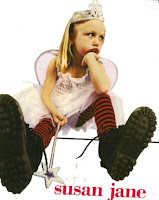
Tales of Growing up Groovy and Clueless
Susan Jane Gilman
Warner Books 2005
"When I was little, I was so girlie and ambitious, I was practically a drag queen." An uncool white kid in a tough Puerto Rican neighborhood twirling around in her tutu.
So begins this collection of Gilman's stories about struggling to get a life and a clue, and engaging in some spectaculary demented behavior along the way.
Her parents were hippies but all she wanted to do was wear a tutu- and she did- to school!!
” I was the child who bragged and lied in Show and Tell to distinguish myself from the hordes of crying and pee-crazy 5-year-olds in Kindergarten. I admit I lied not to be difficult but to be special. I conjured and fantasized on what I wanted to be when I grow up. I wanted to be a doctor, a ballerina, a social worker, a fireman and a nun. All the while feigning nonchalance when the girls in my class also had grander ambitions. I even firmly believed that we’d all be riding flying saucers by the year 2000 just like in the Jetsons.”
Susan Jane Gilman was raised in Upper West Manhattan in the 1970’s, before it became gentrified. Her family was pretty laid back and “groovy” - her grandmother claimed to be a Communist and her mother signed the whole family up for Transcendental Meditation. Throughout it all, Susie retained an active imagination and developed a sense of humor. Her family motto was, “Reality is for people with no imagination.” This is her memoir. It starts in her pre-school years and ends when she moved to Geneva shortly after her marriage
When I saw the little blond scowling girl dressed in a tutu, tiara, fairy wings, striped stockings, and combat boots (and of course carrying a “magic” star wand) I was hooked
Frank McCourt said, 'thank you, O Lord, for sending us Susan Gilman's tales', and Laurie Notaro said, "If you don't absolutely love this book, you are simply dead inside." A bit extreme maybe, but then Laurie was always extreme. I didn’t absolutely love this book, but it was a good read, amusing, and often laugh-out-loud funny.
Monday, September 21, 2009
As always, Jack
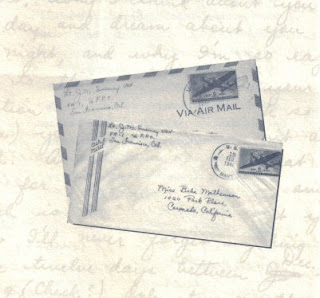
Funny how this book just jumped off the shelf at me. I was walking out of the library, and there it was on the ‘staff picks’ shelf. The name “Jack” caught me because he was a lost love from long ago.
And after I’d just finished reading The Shoebox Bible. Here comes another story of remembrance found on pieces of paper.
This is a beautiful and sweet biography about the author's father whom she never got to meet. Her mother and father met at the end of World War II and got married when he returned home. Over the next ten years, they had four sons, and the author's mother was pregnant with a daughter when his plane was lost at sea. After her mother died, she found a bunch of love letters written to her from her father and this is how she finally got to know him.
Emma Sweeney, the author, was that daughter. She is now a New York literary agent and gardening book author. In the last chapter, she writes:
My father met my mother at the tail end of a year and a half spent in navy flight training at the base near Coronado, California, where she lived. The year was 1945. They had known each other for only eleven days when he left with his flight squadron to report to Hawaii as part of the military's effort to stabilize the Pacific after World War II. Over a period of seven months, he wrote the forty-five letters I found in her drawer.
Pat Conroy, author of Beach Music and Prince of Tides, said, "As Always, Jack is one of the great loves stories of our time. By the time I finished reading these letters, Jack Sweeney had taught me much about humor and longing and almost everything about love."
Monday, September 7, 2009
The Shoebox Bible

Alan Bradley
McClelland & Stewart Ltd.2006
"To all mothers everywhere - and especially mine"
On the floor of her bedroom, he played on rainy days, grating toy cars and trucks endlessly back and forth across the patterned linoleum; beneath her dresser, the fire hall; under her bed, the police station and the hoosegow; and in her closet, the service station and garage, Free air.
It was here he found a well-worn cardboard shoebox beneath a floorboard. "It was an ordinary large, square shoebox - one that might originally have contained galoshes. On one end was a label printed in blue script:"
King Street, Phone 536W
It was a cold, dark winter day during the Second World War. Inside the box he found cigarette packages, soup can labels, handbills, calendars, paper bags, pie boxes – any scrap of paper upon which his mother could copy out snippets of Scripture.
His father left to join the Royal Canadian Air Force, and he grew up in a small southern Ontario town with his mother and two sisters and Jeremiah, his pet turtle that lived in a galvanized washtub.
In the early part of the book, I skipped past the long and tedious quotations from the Bible, but there were many snippets of happy memory from my own childhood growing up in southern Ontario about the same time. Cellars (we call them basements here), galoshes, Eaton's and Simpson's mail-order catalogs, scraping curly shavings of frost from the window, Sweet Caporal cigarette packs.
There are many photographs throughout and wonderful pen-and-ink sketches by Bill Slavin. It’s a beautiful and loving memoir, dedicated to his mother
Sunday, August 23, 2009
Alan Bradley
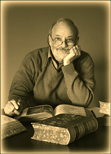
We listened this morning to Alan Bradley being interviewed on CBC Radio. He talked about his books and especially about the Buckshaw Chronicles, the adventures of Flavia deLuce, an 11-year-old aspiring chemist. I wrote about the first of the trilogy in April this year The Sweetness at the Bottom of the Pie and have been waiting eagerly for the next one.
Well, the good news is here. The second book, Tied Up in Strings is coming in March 2010.
Born in Toronto, he lives now in Kelowna with his wife and two calculating cats. I'm off to the library first thing tomorrow to pick up his non-fiction book, The Shoebox Bible.
Wednesday, July 8, 2009
Purple Hibiscus

by Chimamanda Ngozi Adichie
Thomas Allen & Son 2003
"That's a hibiscus, isn't it, Aunty?" Jaja asked, staring at a plant close to the barbed wire fencing. "I didn't know there were purple hibiscuses."
This is a harsh story, almost unbearable at first, but beautifully written.
Fifteen-year-old Kambili and her brother, Jaja, are brought up by an overly strict father in a wealthy Nigerian household. They and their mother are physically abused. Both children live in terror of not achieving the “best-in-class” on school exams because they know the beatings that will follow. There are other forms of torture and cruelty that I won’t describe here.
As things fell apart in the family, the children were allowed to go stay with their aunt in a nearby city. The Aunt and her family were a loving counterpoint to the father's repressive violence. While the children were with the aunt, Jaja was able to explore gardening. He was the one that planted the purple hibiscus in his family's yard when they returned home.
I can't explain why I kept reading this book … it was so unbearably cruel, but I kept coming back to it time and again. I didn't take it back to the library. It was in my book bag to be returned, but it kept calling to me. I'd pull it out and read some more. The purple hibiscus flowers kept turning up, rather like a beacon of hope.
Eventually, I was glad I finished the book because there are some more positive experiences with her Aunt and family and friends, and with her grandfather.
Monday, June 15, 2009
A Good Man is Hard to Find
Flannery O’Connor
Harvest Brace Jovanovich, Publishers
1976
I was first attracted to this book by the title and by the cover.
There are ten short stories here – twisted, sparse, dark, gloomy, funny, dramatic, Southern, angry, sexy, possibly racist, unforgiving, brooding and scary.
Flannery O'Connor was a devout Catholic, which made her a bit of an outsider in the Evangelical Protestant South. She believed in God, but not so much in people. She wrote about ugly, ugly things in such a way that they are completely beautiful. And usually heartbreaking. She painted her characters with exquisite detail,
Someone said she made the south seem even creepier than it already was
Thursday, June 4, 2009
Before the Frost
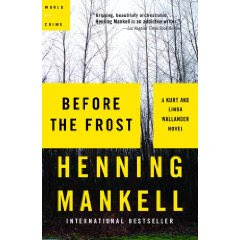
Henning Mankell
translated from the Swedish by Ebba Segerberg
Vintage Canada 2002
Wallander’s daughter, Linda, has just graduated from the police academy and is awaiting her starting position on the local police force in Ystad. They find themselves forced to confront a group of extremists bent on punishing the world's sinners, a group of religious fanatics led by an ex-member of Jim Jones’ congregation in Guyana – one who escaped the mass murders and suicide. The intricate story is deftly told, and the pacing of the action is such that you hate to put the book down – even to go to sleep!
The father/daughter relationship here is quite fascinating, and we learn about Kurt’s moods and temper and weaknesses. She's always ragging him about his bad eating habits and his ever-increasing weight - about his sex life, or lack thereof. There's also a small glimpse into the life of Kurt's ex-wife, Mona. I enjoyed looking into the lives of many of the characters, their lives outside the job. Not just the regular mystery stories I’ve read, I’m looking now for more.
Now I want to visit Sweden. I know so little about that part of the world - I didn't even know there was a bridge between Denmark and Sweden - back to the atlas
Saturday, May 30, 2009
Cold Comfort Farm

by Stella Gibbons
The Folio Society
London 1977
I've tried to read this book three or four times and always give up. It just doesn't appeal to me, and then I wonder what's wrong with me. So many of my bookish friends have high praise
I watched two of the movies or TV miniseries. The earlier one with Alistair Sim in 1971 with C, and we left in the middle of it. We giggled and laughed about it for years after, and called it the Pig Movie. She said she'd never let me choose another movie. Later I watched the 1996 version with Kate Beckinsale and Stephen Fry - same result, gave up part way through.
I borrowed the book from the library several times because this 1971 edition is so beautiful. The cover is dark green cloth with a design of vines and leaves. The water colour illustrations by Quentin Blake are quite gorgeous, fascinating and funny.
 Here, Seth has been left to tend the breakfast meal.
Here, Seth has been left to tend the breakfast meal.In the large kitchen, which occupied most of the middle of the house, a sullen fire burned, the smoke of which wavered up the blackened walls and over the deal table, darkened by age and dirt, which was roughly set for a meal. A snood full of coars porridge hung over the fire, and standing with one arm resting upon the high mantel, looking moodily down into the heaving contents of the snood, was a tall young man whose riding-boots were splashed with mud to the thigh, and whose coarse linen shirt was open to his waist. The firelight lit up his diaphragm muscles as they heaved slowly in rough rhythm with the porridge.
What the heck is a snood?
Tuesday, May 19, 2009
Wallander's First Case

Wallander's First Case is the first of five short stories in Henning Mankell's The Pyramid. I came to read this book (my first by Mankell) after watching the PBS miniseries starring Kenneth Branagh that Nan at Hill Farm reviewed on her blog. You can listen to a fantastic interview with Henning Mankell in Toronto.
These five short mysteries take us back to the beginning and trace chronologically Wallander's growth from a rookie cop into a young father and then a middle-aged divorce.
In 1969, Kurt Wallander was twenty-one years of age, a young policeman, barely an adult, on his first homicide case. His next-door neighbor is dead, seemingly by his own hand. He is still a uniformed police officer in Malmo, tired of walking the streets. With a transfer to Criminal Investigation pending, his future boss encourages his involvement in the investigation. Once involved in a case, he can’t let go until he finds the answer. In this, his first case, he even calls in sick to do more investigating.
There are two problems in his personal life - one with Mona, his girlfriend who is impatient with the interference of his work. And he has issues with his father, an artist who painted the same landscape over and over. The elder Wallander strongly disapproves of his son's decision to join the police force, and frequently derides him for it.
His father has bought a house in Loderup and is moving after 19 years in this house where Wallander had grown up. Anxious that his childhood home was going to be torn down, he thought, "I am sentimental. Perhaps that's why I like opera. The questions is, can you be a good police officer if you have a tendency toward sentimentality?"
So now I've watched two episodes of the PBS series and look forward to the third next week. Apparently there is another series planned as well.
Wednesday, May 13, 2009
The Red Leather Diary Revisited
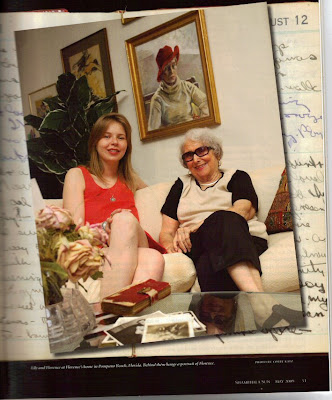
In the May 2009 issue of Shambhala Sun, Lily Koppel writes about her meetings with the author of the diary, Florence Wolfson Howitt. They first met at Florence's home in Connecticut and later in Florida.
Lily discovered the diary in a dumpster in Manhattan in 2003. The journal painted a picture of 1930's New York - horseback riding in Central Park, summer excursions to the Catskills, and an obsession with a famous avant-garde actress, Eva Le Gallienne. Florence began writing the day she received the diary on her fourteenth birthday in 1929. Its nearly 2,000 entries, written in ink that is now faded, captured the passions and ambitions of an intensely creative young woman.
I first wrote about this book on January 6, 2009. At that time I expressed my uncertainty as to the truth of the story. So here now is another look at Lily and Florence. There is a terrific audio interview with Lily and Rod Meade Sperry, one of the magazine's editors, here
I found the connection to Buddhism a bit labored, but interesting. Now I intend to go back and finish reading the diary. I gave up on it about two-thirds of the way through.
Saturday, May 9, 2009
The House of Dolls
Thorndike Press 1991

“Amy Doll, are you telling me that all those old girls upstairs are tarts?”
“Well, not exactly tarts, Doris, but they have gentlemen friends who pay them.”
Trouble is brewing at Amy Doll’s rooming house. Her four ‘golden girl’ boarders, near retirement, have embarked upon a new profession. Well, new to them anyway. In order to supplement their income, the four women traded in their girdles and afternoon tea for tight pants and drink, and began to dabble in the world’s oldest profession. Amy is timid and young and recently widowed, and now a reluctant ‘madam’.
Bertha Jago (she called herself Berti) is a woman of sixty-four, exceptionally tall and bamboo thin, appearing to have no hips, bottom or breasts
Ivy Rope is the youngest of Amy’s ladies – a widow who worked in a haberdashery and woolshop in the nearby Goucester Road
Evelyn Hunter-Smith is a country rector’s daughter (with blue-rinsed hair) and inclined to be a poor man’s edition of Berti. They had a similar build except that Evelyn was not quite as tall and she had a bust, which she considered her best feature. Both were addicted to tight trousers and drink and both had cropped heads
The Senora, as they called her, was in fact a senorita, in spite of her matronly figure. Augustina Puig had been living in the Dolls’ house for over eight years. Amy had never inquired what this magnificent Spanish woman was doing in a Walham Green horse meat shop or wondered who she came to leave her country. Her husband had brought her home one evening when he was engaged in decorating the horsemeat shop. “She’d fit nicely into the big room at the top,’ he said, ‘and the money she brings will pay for Hetty’s schooling.
This book is quite delightful – one long chuckle from beginning to end. Occasionally a great guffaw.
“Berti skimmed in, kissing the Greek on both cheeks, and spun round like a top in front of Ivy and Evelyn. She appeared to have a pair of dehydrated moths on her eyes. ‘Do you like them, dears? False eyelashes. I found them at the back of one of the drawers, must be at least ten years old, but very alluring.’ She fluttered the dehydrated moths over her almost-closed eyes.
“’ Can you see with them?’ Ivy asked bleakly. ‘Not very well, but as long as I can see my drink, that’s all that matters.’ Evelyn was still staring. ‘How have you fixed them?’ she enquired. ‘Actually with glue. There wasn’t anything else. It stings a bit. Do you think they look all right?’
Monday, May 4, 2009
A Partisan's Daughter
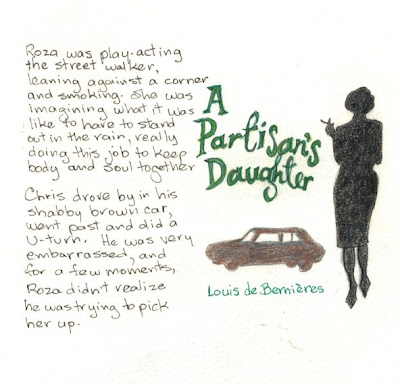
by Louis de Bernieres
Alfred A. Knopf Canada 2008
This is the story of Christopher and Roza. Christopher is a bored pharmaceutical salesman in London who suddenly decides to do something different. He is plagued with a wife at home who has become indifferent to him and to the world. He refers to her as, “a great loaf of white bread.” Roza is a Yugoslavian refugee whose father was a partisan during the war, and decides that it might be fun to dress up like a street walker and see what happens.
This is London in the early 1970s. Chris is a man in classic midlife crisis. His marriage is loveless, and his salesman job more or less meaningless. When Chris meets Roza, a woman he mistakes for a prostitute, he falls into a kind of obsession that sees him returning again and again to listen to stories from her past that she uses to keep him coming back. Thus starts a non-sexual relationship that is akin to the story of Scherezade. They meet regularly and Chris becomes more and more enamoured with her.
Friday, May 1, 2009
Burnt Shadows

9 August 1945, Nagasaki, Hiroko Tanaka steps out onto her veranda, taking in the view of the terraced slopes leading up to the sky. Wrapped in a kimono with three black cranes swooping across the back, she is twenty-one and in love with the man she is to marry, Konrad Weiss.
In a split second, the world turns white. In the next, it explodes with the sound of fire and the horror of realisation. In the numbing aftermath of a bomb that obliterates everything she has known, all that remains are the bird-shaped burns on her back, an indelible reminder of the world she has lost.
This wonderful story follows Hiroko from Nagasaki to Delhi to Pakistan and Afghanistan, and finally to New York and back to Afghanistan in the wake of 9/11. Salman Rushdie said of Kamila Shamsie, "a writer of immense ambition and strength."
This book came to me as a winner of the book draw given by Lynne at DoveGreyReader, where you can find a full review. Thank you so much Lynne and to Bloomsbury as well.
Thursday, April 30, 2009
Hotel on the Corner of Bitter and Sweet
Ballantine Books
New York 2009
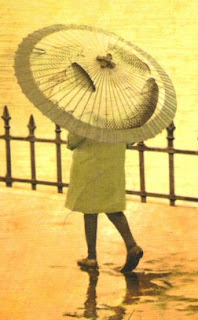
Henry Lee comes upon a crowd gathered outside the Panama Hotel, once the gateway to Seattle's Japantown. The old Seattle landmark was a place he'd visited twice in his lifetime. First when he was only twelve years old, way back in 1942 - "the war years" he liked to call them. Even then the old bachelor hotel had stood as a gateway between Seattle's Chinatown and Nihonmachi, Japantown. Two outposts of an old-world conflict where Chinese and Japanese immigrants rarely spoke to one another, while their American-born children often played in the streets together.
It has been boarded up for decades, but now the new owner has made an incredible discovery: the belongings of Japanese families, left when they were rounded up and sent to internment camps during World War II. As Henry looks on, the owner opens a Japanese parasol. This simple act takes old Henry Lee back to the 1940s
This is the story of Henry Lee (a Chinese American) through transitions in time between the 1940s and 1986 in Seattle. At the Japanese internment camp in Idaho, the young Henry gets a job as a server in the kitchen, and is able to visit his sweetheart, Keiko. In Seattle, in 1986, the older Henry begins to know his grown son, Marty. Henry was a widower now, and it was lonely ... there was an "Ethel-shaped hole" in his life without her.
The Panama Hotel is central to the story throughout. The new owner allows Henry and Marty to search in the dusty basement for belongings of Keiko's family ... particulary for a long-lost object whose value he cannot even begin to measure.
Thursday, April 16, 2009
The Sweetness at the Bottom of the Pie
Doubleday Canada 2009
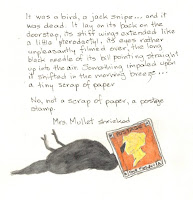
A series of inexplicable events has struck Buckshaw, the decaying English mansion that Flavia's family calls home. For eleven-year-old Flavia, life begins in earnest when murder comes to Buckshaw. A dead bird is found on the doorstep, a postage stamp bizarrely pinned to its beak.
This is the first in a series that Bradley has planned - The Buckshaw Chronicles. I will be on the edge of my seat waiting for the second
The Sweetness at the Bottom of the Pie is set in the summer of 1950, following Flavia de Luce as she attempts to solve the mystery of the man who was found dead in her family's cucumber patch in the early hours of the morning
Flavia possesses a love of chemistry, a passion for poisons in particular, a bicycle named Gladys, and a talent for deductive reasoning. (Could our Flavia somehow be the adolescent female version of Sherlock Holmes?)
Tuesday, April 7, 2009
A Taste of Heaven and Earth
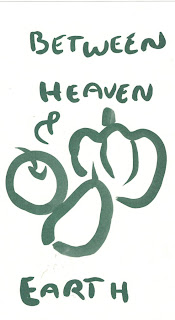
A Zen Approach to Cooking and Eating
by Bettina Vitell
Harper Collins 1993
I wrote about this in my other blog My Zen Diary. There are great vegetarian recipes here, but also short stories and contemplative essays precede each section: soups, pasta and grains, curries, Mexican tastes, Sushi ideas, Pizzas and Vegetable Tarts, Vegetable Dishes, Salads, Sauces and salad dressings, breakfast ideas, and deserts. Beautiful ink drawings grace most pages.
Monday, March 30, 2009
Living Color
"I realized nothing I have ever created held the light the way a leaf did or caught the shadow in a white room. No painting I've done matched the peace I've felt at twilight or the feeling of loss I've experienced at bleached high noon in New Mexico. But I wasn't going to let that stop me. I was crazy about the wrong color sky and the heart-sinking beckoning of headlights on old cars. I painted for that terrible overused word that a writer should never utter: love. For that reason, I kept trying to catch up to the picture just ahead of me in my mind and before me on the porch."
One of my favorite authors and Buddhist friends writes about her life and illustrates it 'in living color'. Here is a tiny excerpt to give the flavor "I noticed that the blue of my paints wasn't blue enough to get the intensity of that New Mexico sky. I painted the sky red instead." Tender stories of family and friends ... the paintings of her father are extraordinary.
After knowing Natalie as a writer, author, and teacher ... Wild Mind and Writing Down the Bones, Long Quiet Highway and The Great Failure, I was happy to discover her paintings and life stories. The colors, oh the colors, a purple adobe house in Hopi Land, blue and green skyscrapers in New York City, a blue adobe house in Santa Fe.
There's a chapter devoted to her grandfather and a series of paintings of trucks.
If you own this book now, you probably shouldn't lend it. You may never get it back again.
Sunday, March 22, 2009
In the Land of the Midnight Sun
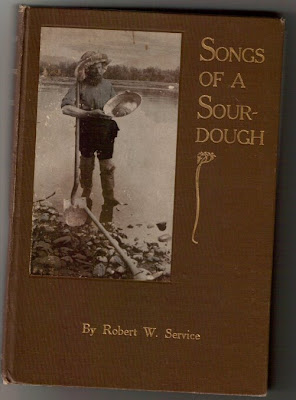

This book belonged to my father. I found it recently while cleaning out the storage closet. It's a gorgeous 1911 edition ... thick creamy pages and decal edges.
Robert Service was born in England, raised in Scotland, farmed in Duncan, British Columbia, banked in Victoria, drifted in California, wrote in Whitehorse, married in Paris, hid in Vancouver, died in Brittany and was buried in Monte Carlo. He dedicated this book to "C.M." I wonder who that was.
In San Francisco, he drank in seedy bars, got into street fights and was virtually in the gutter. Desperate for money, he took a labouring job that required him to move to Los Angeles, only to find that he was a strikebreaker. That didn't bother him, but the back-breaking work on a tunnel and the danger he faced to life and limb made him quit. He drifted from job to job as a dishwasher, a sandwich-board man and an orange picker. An ad he had put in the paper seemed to be his answer - a resident handyman was required in a high-class establishment. Eagerly, he took the job and moved in. It was a brothel.
After more wandering in Mexico, Utah, Texas, Arizona, Nevada and Colorado, he returned to Vancouver Island, having been away for 18 months. He prospered in Victoria. While working at the Canadian Bank of Commerce, he was leafing through the bank's ledger one day and spotted the name of a customer - Sam McGee. Perfect! Using the name of the unsuspecting gentleman, he published the ballad that, along with several others, propelled him to fame and fortune.
He served as an ambulance driver in the First World War, then settled in France.
At the outbreak of the Second World War, he became a wanted man by the Nazis for mocking Hitler, but managed to escape to Vancouver in 1940 with his wife, Germaine, whom he had married in Paris in 1913.
His biographer, Enid Mallory, wrote, "Words were his lifelong passion ... he could make them dance, shiver with cold or choke with loneliness and despair ... but they danced their best on the wide white stage of the Canadian North."
Wednesday, March 18, 2009
Isabel's Daughter

“The first time I saw my mother was the night she died. The second time was at a party in Santa Fe.”
Avery James spent the first 13 years of her life in a foundling home in Alamitos Colorado, near the New Mexican border. Her best friend was Esperanza Verdug – a round person with long gray braid, snapping dark eyes, smooth brown arms, and a gold front tooth. The cook at Carson. Not a housemother or a teacher or a nurse. No degree in psychology or social work or early childhood eduction. No counseling credentials. If the truth be told, she couldn’t read or write, and her English sometimes sent me into fits of laughter.
But of all the Carson staff, it was Esperanza who always seemed to be wading through a river of kids. They’d hang on her arms, grab at her skirts, cling to her legs. She was the one who tied shoelaces, wiped runny noses, smuggled bizochitos into the library.
After Esperanza died, Avery ran away to Florales where she finds a rural haven provided by an eccentric old woman called Cassie, a curandera, or healer, who teaches her how to concoct remedies from wild plants. She lived with Cassie for many years, until the old woman died, helping in the garden and with the cooking.
Eventually she finds her way to Santa Fe and the famed art colonies. Working for a trendy caterer, she sees the portrait of a woman who bears a striking resemblance to her in the home of a client. Avery's search for her mother is revealed in flashbacks.
When she was living with Cassie, she was bitten by a rattlesnake. Recovering in hospital- "When they stuck needles in my arm I knew it should hurt, but I couldn’t feel it. I remember Cassies’ face hovering over me in a blue cloud, then her hand on my forehead.
"It was still dark, and I wondered what time it was. I started to call for a nurse, but the sound died in my throat. A woman was standing in the doorway. She was wearing a black dress with white sleeves. The multicolored beads on her dress caught the dim light from the hall and made it sparkle. She had long black hair and her face was shadows. I figures she was an angel, and that seeing her meant I was going to die. Except I didn’t think angels wore black, so maybe she was a bad angel and I was going to Hell for not believing. I stared harder, trying to see her face, but I couldn’t. She just stood there like she was watching me.
"All at once I know, and the knowing made the hair rise up all over my head.
"She was my mother."
Tuesday, March 17, 2009
There's a (Slight) Chance I Might be Going to Hell

This story takes place in the Pacific Northwest, my home ground. It's very very funny, and I enjoyed it thoroughly ... listened to it as an audiobook. The author describes people and places so well that I thought I could see them and hear them.
Spaulding is a quintessential college hippie town, laid-back and full of quirky characters. The town is founded on a sewer pipe manufacturing company, though it's been closed for years now. The big annual event is the Sewer Pipe Festival, complete with the crowning of a queen. This is a recycling, no-meat-eating town, and Maye resorts to telling lies to find friends. This, she reflects, is earning her places in the different degrees of hell. There's an intermediate hell where one is forced to live out eternity in Wal-Mart "the day after Thanksgiving as shoppers jostled, pushed and rubbed against her to secure the cheapest things hellishly possible, while their children, also known as demi-demons, cried, screamed, and begged for hell's cuisine, corn dogs and Mountain Dew."
After narrow escapes from a coven of witches, a cult of vegetarians (she loves a good steak) and an alcoholic who humiliates her on a friend-date, she decides to enter the town's Sewer Pipe Queen pageant in hopes this will help her attract friends.
Sunday, March 1, 2009
Eudora
Nan at Letters from a Hill Farm said she would devote the month of April to reading Eudora Welty. I have a treasured copy of "The Collected Stories of Eudora Welty" that I bring out from time to time to re-read some favorites. Her vision is sweet by nature, and she writes with a fine, pure, and gentle voice about the American South. This year will be her 100th birthday
I posted an entry in My Reading Diary a few years ago, and mentioned her connection to the email system that bears her name

The Birth of Eudora
Originally developed as a freeware product by Internet pioneer Steve Dorner in 1988, Eudora broke new ground by combining the best attributes of various emerging email technologies. The program did not spring from a traditional center of high-tech innovation such as the Silicon Valley, but rather, from a college campus in the nation's heartland.
Eudora was developed by Steve Dorner at the University of Illinois, where Mosaic was also eventually developed. Dorner was a computer programmer working on TCP/IP (transmission control protocol/Internet protocol) applications and servers for the computer science department on the Urbana-Champaign campus. This was his first exposure to Internet protocols, chiefly file transfer protocol (ftp) and telnet, before he moved on to developing "ph" for Net directories.
After growing bored with building directories, Dorner turned his attention to email. Although electronic messaging was still in its infancy, Dorner realized that an elegant email system could greatly enhance and facilitate communications among students and faculty on campus.
The Name
After working on the new email program for a year, Dorner was ready to release it for free to the Internet community at large. The working name was UIUCMail, which Dorner realized was a tongue twister. Then he remembered a short story written by Eudora Welty (1909-2001) titled "Why I Live at the P.O." It's a story about a woman who decides to live at the post office where she works rather than put up with her family at home any longer. Dorner was processing so much email at the time that he felt like he lived at the post office, and his program used a "post office" protocol to fetch mail, so he saw a metaphorical connection. Since the programming and naming took place a decade ahead of the phenomenal growth of the Internet, Dorner hadn't anticipated Eudora would eventually be used by more than 20 million people.
Naming the program after a living author could have become awkward for Dorner and any future licensees. Fortunately, Ms. Welty was flattered and amused by the allusion to her and her work.
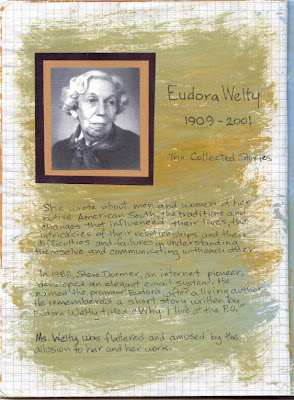
I love this anecdote about Eudora Welty and the email system ... it's the same one I've been using for many years now
A short story writer and novelist, Eudora Welty wrote poignantly about the men and women of her native American South, the traditions and changes that influenced their lives, the intricacies of their relationships and their difficulties and failures in understanding themselves and communicating with each other, passed away on July 23, 2001.
Miss Welty and other Southern writers of her generation such as William Faulkner, Flannery O'Connor, Allen Tate, Tennessee Williams and Robert Penn Warren, were key figures in the movement that created a Southern literary renaissance during the 1930s, 1940s and 1950s and made Southern writing a dominant force in 20th century American literature.
Tuesday, January 6, 2009
The Red Leather Diary
Reclaiming a Life Through the Pages of a Lost Journal
Lily Koppel
Harper Collins 2008
In 2003, Lily Koppel discovered Florence Wolfson’s diary in a Manhattan dumpster. She located Florence in Florida and surprised her with this artifact from her past. Lily said, “I have some old things belonging to you that I picked up at 98 Riverside Drive, and I thought you might want them.”
As a teenager, Florence had kept the diary from 1929 to 1934. Lily wrote a piece for The New York Times based on this 72-year-old relic, provoking enough interest to be turned into a book. Florence writes in a forward to the book, “It has added zest to my life and brought back some of the passion of my youth and made me feel more alive than I have in years.”
Because this was written in a novelistic way, I found it hard to decide if it was fact or fiction. Either way, it is a fascinating re-creation of the romance and glitter, sophistication and promise, of 1930s New York. She was obsessed with the state of her soul and her appearance, and I probably wouldn’t have liked Florence at all.

In June 2008, one reviewer said that she had seen them on the Today show. Maybe it’s true, maybe not, nevertheless, a good read and the black-and-white photos add lots of interest.
Florence as a sixteen-year-old college sophomore in May 1931
